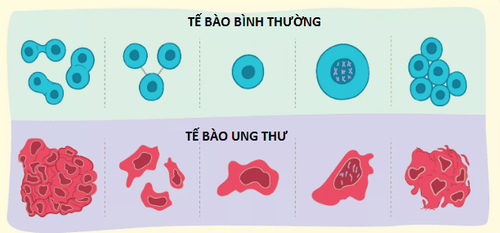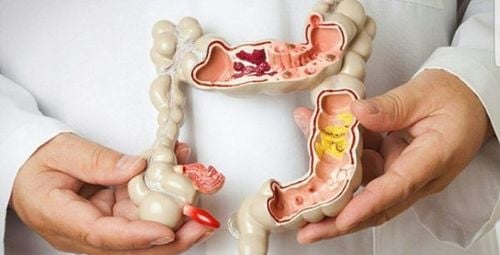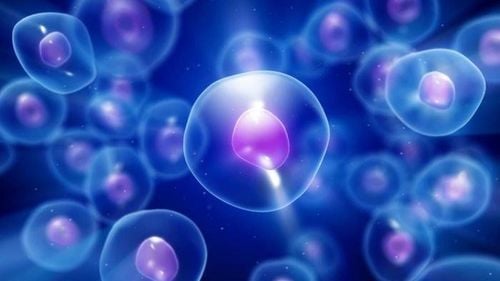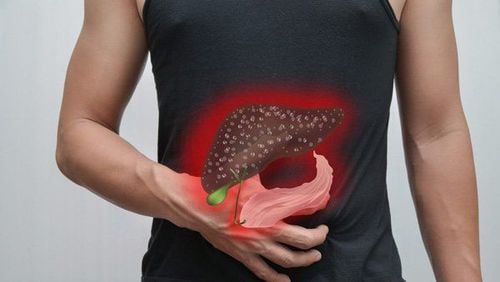A healthy, normal cell has a life cycle of development, division, and death. Cancer cells do not follow this normal cycle. Instead of dying as part of the usual cycle, cancer cells produce many more abnormal cells that can invade surrounding tissues. They can also invade the blood and lymphatic systems to other parts of the body.
1. Does everyone have cancer cells in their body?
Not everyone has cancer cells in their body. Our bodies continuously produce new cells, some of which may have the potential to become cancerous. At any given time, your body can create cells with damaged DNA, but this does not mean they will develop into cancer.
Normally, cells with damaged DNA would either repair themselves or die through a process called apoptosis. Cancer potential only occurs when both of 2 processes fail to take place.
2. How do cancer cells differ from normal cells?
Normal cells follow instructions, while cancer cells do not follow these instructions.
Normal cells will only grow and divide when necessary, to replace similar cells that are damaged or aged. Mature cells have specialized functions, once they have completed their purposes, they die, ending their life cycle.
Cancer cells carry mutated genes and are less specialized than normal cells. At the same time, they do not follow the normal processes of a cell. Regardless of whether they are necessary or not, they will continue to grow and divide and will not die when necessary.
Cancer cells multiply to form tumors and metastasize to surrounding tissues. These cells can also break free from the tumor and move to other parts of the body.
Cancer cells can affect the functioning of normal cells, worsening the situation. As they can stimulate the growth of new blood vessels to nourish themselves.
Cancer cells often evade the attack of the immune system by suppressing immune cells, preventing immune cells from distinguishing them from normal cells.

3. What is the difference between benign and malignant cells?
There is a significant difference between what are known as benign and malignant cells.
Sometimes, benign cells proliferate excessively and form tumors, but they do not have the ability to invade other tissues and are not considered cancerous. Benign cells are typically not life-threatening, but they can become dangerous if they grow too large or compress internal organs. A benign tumor can still be a life-threatening if it’s a brain tumor. When a benign tumor is removed, it does not have the ability to grow back. Since benign cells do not spread, no treatment is needed to prevent them from returning.
Malignant cells are cancerous and have the potential to be life-threatening. They can invade nearby tissues and metastasize throughout the body. When a malignant tumor is removed, any remaining cells can lead to new growth. This is why cancer treatment often requires additional therapies, such as chemotherapy, immunotherapy, or radiation, to eliminate all cancer cells throughout the body.
4. What causes cancer?
The development of cancer cells in the body is related to DNA damage. Genetic mutations are responsible for 5-10% of all cancers. Having one of these genetic mutations increases the risk of developing cancer, but it is not inevitable.
You can also acquire genetic mutations through other factors, including:
- Chemicals in cigarette smoke.
- Ultraviolet (UV) rays.
- Exposure to radiation, including radiation therapy.
- A poor diet, including consuming a lot of processed meats.
- Lack of physical activity.
- Alcohol abuse
- Exposure to chemicals such as lead, radon, and asbestos.
- Infections such as human papillomavirus (HPV) and hepatitis viruses.
It’s not always possible to point out the exact reason why someone develops cancer. A combination of several factors may contribute to the onset of cancer. When a cell mutates, the mutation is passed on to every new cell it creates.
5. What can you do to reduce the risk of cancerous cell development in your body?
You cannot completely eliminate the risk of cancer, but there are things you can do to reduce your risk:
- Avoid tobacco: This includes cigars, cigarettes, pipes, and smokeless tobacco products. In the United States, one in three cancer-related deaths is due to smoking.
- Cancer screenings: Certain tests, such as Pap smears and colonoscopies, can detect abnormal cells before they have a chance to become cancerous. Other screenings, like mammograms, can detect localized cancer cells before they begin to spread.
- Limit alcohol consumption: Alcoholic beverages such as wine and spirits contain ethanol, which increases cancer risk over time. Alcohol should be limited to one drink per day for women and two drinks per day for men.
- Protect your skin from the sun: Avoid UV rays by covering your skin and using broad-spectrum sunscreen with at least SPF 30. Avoid sun exposure at noon or using Tanning beds or tanning lamps.
- Follow a healthy, balanced diet: Try to incorporate plenty of vegetables, fruits, and whole grains into your diet. Limit processed foods, sugar, red meat, and processed meats.
- Exercise: Lack of physical activity can increase cancer risk. Try to get at least 150 minutes of moderate-intensity exercise or 75 minutes of vigorous activity each week.
- Talk to your doctor about vaccines that may help reduce the risk of certain cancers. The HPV virus causes a sexually transmitted infection (STI) passed through skin-to-skin contact. It can lead to cervical, genital, and head and neck cancers. The Centers for Disease Control and Prevention (CDC) recommends the HPV vaccine for most people aged 9-26.
In addition, there is the hepatitis B vaccine, a viral infection that can increase the risk of liver cancer. Talk to your doctor about your cancer risk and what other steps you can take to reduce those risks.
Not everyone has cancer cells in their body. The number of cells that your body continuously creates is very large, which means there is always a possibility that some cells may become abnormal. Even when this happens, those damaged cells will not eventually turn into cancer.
Cancer often originates from DNA damage through genetic mutations or something you come into contact within daily life. While you can't control genetic mutations, certain lifestyle changes can help reduce the risk of developing cancer, including regular cancer screenings to catch cancer before it starts.
Early cancer screenings are considered the "golden key" to early detection and providing methods to prevent and treat cancer effectively, reducing the risk of death and healthcare costs for patients. Currently, Vinmec is a leading medical facility in the field of cancer detection and screening, offering you the opportunity for timely screenings and early identification of warning signs, optimizing treatment effectiveness and improving quality of life.
Please dial HOTLINE for more information or register for an appointment HERE. Download MyVinmec app to make appointments faster and to manage your bookings easily.
Reference source: healthline.com
To arrange an appointment, please call HOTLINE or make your reservation directly HERE. You may also download the MyVinmec app to schedule appointments faster and manage your reservations more conveniently.








